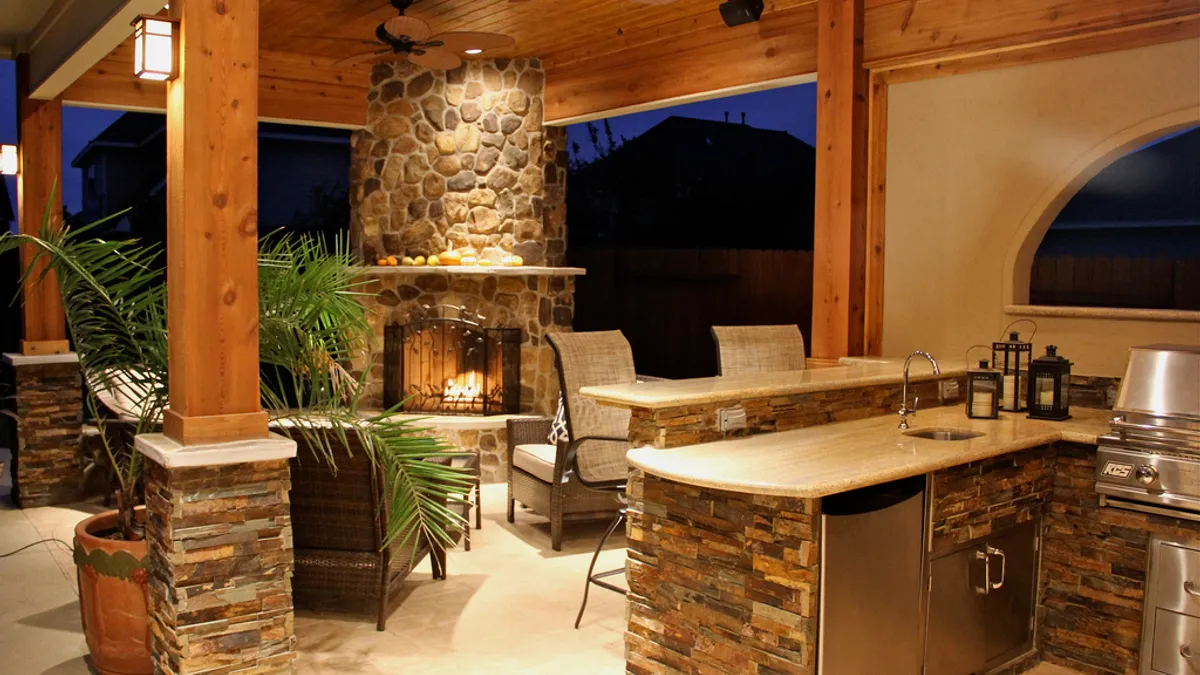Kicking back outdoors during the warm, summer months is a pastime that’s not expected to go away any time soon. If anything, owners today want to get more out of their outdoor living spaces. And they are doing so by adding features from robust kitchens and big-screen TVs to natural materials and extra storage.
Outdoor living areas continue to yield a significant return on owners’ initial investment, according to Remodeling’s 2017 Cost Vs. Value report, which recorded returns of 54.9% to 71% in the costs to build features such as backyard patios and deck additions upon resale.
Six in 10 (58%) architectural practices surveyed last year by the American Institute of Architects said outdoor living spaces were popular features in the homes they built, down slightly from the share who said the same (62%) in 2015.
Here's how the products and systems shaping the outdoor living category are expected to fare in 2017.
Wood alternatives grow their share
Six in 10 homeowners taking on landscape projects this year said they plan to include a patio, terrace or deck, according to a recent Houzz survey. While patios trend toward pavers, flagstone and concrete, for decks, the battle between pressure-treated wood, composite and plastic continues.
Overall, demand for decking is up, with Cleveland-based market research firm the Freedonia Group projecting annual growth of 1.8% through 2020 to a value of $7.1 billion. Although wood will continue to dominate the market, the wood-plastic composite and plastic categories are expected to grow their share at an above-average rate through 2020, driven in part by the growing use of cellular PVC material for its wood look and weather resistance.
Cost comparisons find wood to 40% to 50% less-expensive per square foot than alternative products, on average, but since it can rot, splinter and fade and requires ongoing staining, sealing and sanding, its total cost over the life of the deck creeps up. In its report, Remodeling found that a mid-range wood deck addition had a higher return on investment (71.5% recouped) than a mid-range (65.2%) or high-end (56.4%) composite addition upon resale. Freedonia predicts wood will continue to be the leading decking material due to its low initial costs.
Bringing the kitchen outdoors
The focal point of many of these new patios and decks is the outdoor kitchen, which a separate design trends report from the AIA for Q4 2016 notes is beginning to rival the detail and design of its indoor counterpart. Remodelers are taking note. “We’re seeing an increase in business,” says Mark Allen, owner of Outdoor Kitchens by Design in Orange Park, FL, noting that people have returned to investing in their backyard spaces after a lull in such activity during the recession.
Today’s outdoor kitchens are continuing to evolve from a time when cooking outside didn’t include much more than a grill. Cabinets are stylish and durable enough for the elements but are also functional, as they hide plumbing and gas hookups that connect to exterior-grade ovens, searing stations, dishwashers and sinks. Add warming drawers, microwaves and refrigerators and a complete meal can be prepared, enjoyed and even cleaned up, all in the great outdoors.
As comparable as these kitchens can be to the one indoors, it’s not always as easy to build. For example, dishwashers and sinks require plumbing, which isn’t a simple addition, especially after the fact, Allen says. He has noticed more newly built homes with plumbing, electric and gas connections already at the likely site of a future outdoor kitchen space.
Location plays a role beyond the number of days an outdoor living space may be reasonably usable. Building decks and patios in the mountains of Colorado requires accounting for a wide range of temperatures and the typical freeze-thaw cycles that can occur in late fall through winter and into the spring. If sinks and dishwashers are included, winterizing water and drain lines is required, says Bob Boymer, owner of R. Boymer Construction in Vail, CO.
Other tips for planning outdoor spaces, provided by The House Designers, a company that offers design information and architectural house plans, include: incorporating durable and slip-resistant floor materials; installing countertops that are easy to clean but can handle varying weather conditions; and extending the outdoor season with fireplaces or other heat sources.
Making outdoor living spaces stand out
Homeowners all have one thing in common, Allen says, which is that they want something unique. One product he says is gaining ground is the flat top cooker, which lets people gather around while food is being prepared. His customers also like an L-shaped cooking station and seating area, undercounter refrigerators and stainless steel ice chests.
Working with budgets from $10,000 to $60,000, Bryant Klare, owner of Backyard Kitchens in Houston, TX, has seen his business increase around 30% as the popularity of outdoor living continues. The projects typically add on to existing decks to gain more space. One of the newer trends he sees includes enclosing a kamado-style ceramic cooker and smoker.
Folding glass patio doors is another feature homeowners typically consider to bridge indoor and outdoor living areas visually and functionally, according to Boymer. For uncovered spaces, retractable awnings are another design element that can provide shade and weather protection when needed, he says.
Decking company Dekorators calls out additional outdoor living trends in its blog, including the use of distressed materials and complementary color schemes as well as wide rails to place drinks and food plates during parties, and the use of the covered area under an elevated deck as additional outdoor living space.
Lighting is another trend keeping up with today’s outdoor kitchens. The evolution from the bright-bulbed sconce once installed next to the door has evolved into an entire system of landscape, stair, rail and path lights that offer a mix of ambient, task and safety lighting. In the green tradition, Houzz noted, almost half of outdoor projects today involve a lighting upgrade with 73% choosing LED and 41% solar.










